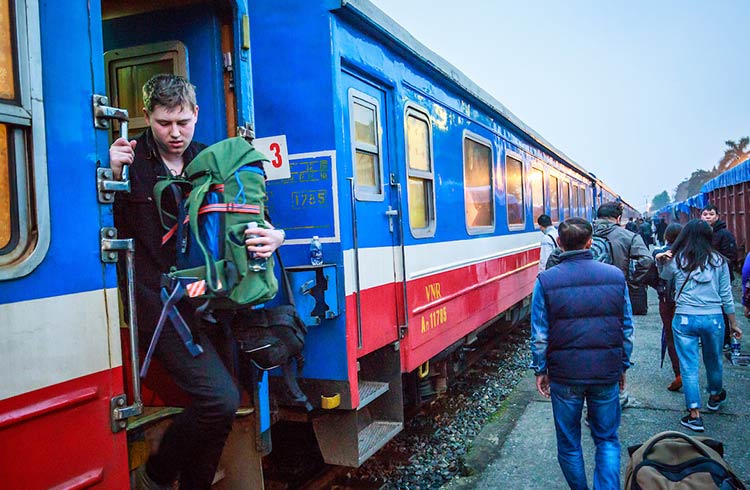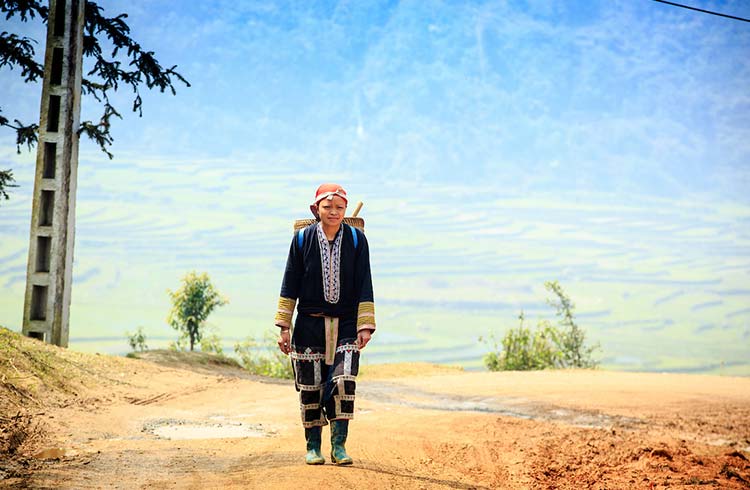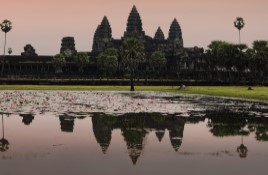Logistics of Traveling Around Vietnam, Cambodia & Laos
Planning an epic trip around southeast Asia, but getting bogged down in the details? Here’s everything you need to know about border crossings, visas, transport, and changing money before you travel to Vietnam, Cambodia and Laos.
 Photo © Brian Rapsey
Photo © Brian Rapsey
- Border crossings
- Do’s and don’ts
- Visa information
- Currency exchange
- Transport
- Traveling around via motorbike
Border crossings
The fastest and most convenient (and likely, the most expensive) way to travel between these countries is to fly and skip the crossings entirely. There are a range of overland options, however. Traveling overland between Thailand, Cambodia, Vietnam and Laos used to be a long process. These days, it’s slightly faster, and some of the borders even have nice air-conditioned rooms for you to wait in while you fill out your forms. But, you still have to allow an hour or two, be ready to stand in line for a while, and expect to carry your own bags across the border. There are people who will offer to help (for a small price) but letting your bags out of sight – even for a moment – could be a recipe for disaster.
Most visitors will arrive in Thailand and cross into Cambodia at the notorious Poipet border. Although it has improved in recent years, the best way to avoid any uncomfortable run-ins with the infamous border scammers (which can include bogus officials) is to hold onto your passport and hand it over at the counter yourself, keeping some small bills for any extra ‘fees’ you might entail, preferably paid in USD. Never give your passport to anyone who isn’t standing behind the counter.
It’s also worth bearing in mind that while you’re waiting at the entry terminal at the border, the bus company will occasionally give everyone’s passports in together to save time, such as at the Ha Tien and Chau Doc border between Vietnam and Cambodia. When they are done processing the visa they will call out your name, take your fingerprints and give you your passport back.
When crossing the border, ensure you have passport photos, a pen to fill out the visa forms, and your first night’s accommodation sorted, in case you are asked for an address. Having small change available for any necessary trips to the bathroom is also advisable.
It's also possible to take a train from Bangkok to Aranyaprathet, on the Thai side of the border with Cambodia, and take a bus or taxi for the rest of your journey. There are currently no international trains available between Vietnam and Cambodia or Laos.
A few extra top tips include:
- Try not to overstay your visa in any country (or you might face a fine or the possibility of detention and/or deportment).
- Keep your exit forms, and any pieces of paper that they staple into your passport safe, as fines for losing these can also add up.
Do’s and don’ts
Do: check your visa requirements before you go. Most nationalities need to get a visa before arrival to Vietnam, so don’t risk being turned around at the border.
Do: double check your passport has blank visa pages and is valid for at least six months.
Do: ensure you have passport photos and the exact change for your visa. Visas for Laos and Cambodia should be paid in USD.
Do: keep small bills such as US $1 in your pocket in case of any extra ‘fees’. Although you can try and make a stand and fight these, it’s not always worth it and the bus driver isn’t guaranteed to wait for you.
Do: your research. Try not to travel on weekends and public holidays where possible, and if using private transport, try to avoid the border’s busiest times, such as the morning and the afternoon when all the buses arrive. There’s nothing like waiting at the back of a long queue of 150 people when three buses show up at once! Be aware that if you arrive at the border late they might also charge extra fees for the inconvenience.
Do: show respect, be patient and courteous. A smile goes a long way!
Don’t: let your bags out of sight. Turn your back for a moment and they might just disappear.

Visa information
In both Cambodia and Laos, most border crossings and international airports allow visas on arrival for visitors from most European countries, as well as the US, Canada, Australia, and New Zealand. These cost around US $35, but be sure to double check the price before you travel and have the exact amount in US dollars.
Those traveling on passports from Asian, South American, African, and Middle Eastern countries should double check first and apply for a visa before arrival if necessary.
Vietnam allows certain Asian and European countries such as the UK 15 days of visa-free entry, although citizens of other countries such as Australia, the US, and Canada still need to apply for visas before arrival. This can be done online as an e-visa, via a letter of approval, or by applying at the nearest consulate before you travel. Some airports also offer visas on arrival for certain nationalities who are flying in, so it’s worth double checking your country’s requirements beforehand.
Currency exchange
Be sure to change some money over before you arrive in each country, especially if you need USD to pay for your visas. The border exchange rates on the Thai side of the Cambodian border aren’t too bad, but it’s worth being prepared so you can afford that toasted sandwich from 7/11 on the long drive back to Bangkok!
You can often find the best exchange rates at the local market, although it is worth shopping around to see who will give you the best deal, and you should always check for fake or torn bills. The bank and official exchange offices can also change money, but the rates can be higher. I recommend downloading the XE app so you know the current exchange rate, and can ensure you’re not getting ripped off.
Transport within Vietnam, Cambodia, and Laos
The best and most affordable way to get around in each country is generally by bus, although the train journey through Vietnam is absolutely spectacular and can provide a nice change of scenery. There are several different bus companies that service the main tourist hot-spots in each country, and local buses will get you to remote areas if you want to go far off the beaten track.
When traveling by bus always keep all your valuables in your hand luggage and try to keep it as secure as possible, especially before falling asleep. Unfortunately, theft is common on buses, so exercise caution where possible and try to keep your phone hidden as best as possible.
Another thing to note is that a lot of buses drop you off at bus stations a little way out of the main city, so you have to be prepared to haggle for a taxi or Tuk Tuk to your hotel. If you can, make friends on the bus to split the cost, and if all else fails, turn down the price and start walking towards town – a driver will likely chase after you and offer a discounted price. However, it might be worth downloading an offline map and saving your destination just in case they call your bluff and you end up having to walk all the way on your own.
Traveling around via motorbike
An increasingly popular way to get around is to travel by motorbike. Please note, it is mandatory to have a Vietnamese driving license to ride any motorcycle over 50cc, and it is currently impossible to get a Vietnamese driving license on a tourist visa and without being resident of the country for at least three months. Without this, your travel insurance won’t cover you if you get into an accident, and the local police may pull you over and impound your motorbike if they catch you riding without a license.
Most companies require proof of your motorbike license from your home country before they will cover you, so you should always ensure you have the paperwork in order before you buy or rent a bike and take to the open road.
If you choose to ride, consider travel insurance and be sure to comply with its requirements, such as riding with a helmet and being appropriately licensed.
Related articles
Simple and flexible travel insurance
You can buy at home or while traveling, and claim online from anywhere in the world. With 150+ adventure activities covered and 24/7 emergency assistance.
Get a quote


1 Comment
Would love to travel to Laos, Cambodia and Thailand some day...